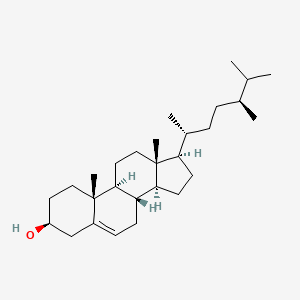| MeSH term | MeSH ID | Detail |
|---|---|---|
| Coronary Disease | D003327 | 70 associated lipids |
| Hypercholesterolemia | D006937 | 91 associated lipids |
| Hyperlipoproteinemia Type II | D006938 | 22 associated lipids |
| Hyperlipidemias | D006949 | 73 associated lipids |
| Hypolipoproteinemias | D007009 | 9 associated lipids |
| Xanthomatosis | D014973 | 17 associated lipids |
| Metabolic Syndrome | D024821 | 44 associated lipids |
22,23-dihydrobrassicasterol
22,23-dihydrobrassicasterol is a lipid of Sterol Lipids (ST) class. 22,23-dihydrobrassicasterol is associated with abnormalities such as Diabetes, Macular degeneration, Drusen, Systemic disease and Diabetes Mellitus. The involved functions are known as cholesterol metabolism, Synthesis, Intestinal Absorption, Liver function and cholesterol absorption. 22,23-dihydrobrassicasterol often locates in Back and Cell membrane. The associated genes with 22,23-dihydrobrassicasterol are apolipoprotein E-3. The related lipids are Total cholesterol, campesterol, lathosterol, Fatty Acids, Nonesterified and Cholesterol, Dietary.
Cross Reference
Introduction
To understand associated biological information of 22,23-dihydrobrassicasterol, we collected biological information of abnormalities, associated pathways, cellular/molecular locations, biological functions, related genes/proteins, lipids and common seen animal/experimental models with organized paragraphs from literatures.
What diseases are associated with 22,23-dihydrobrassicasterol?
22,23-dihydrobrassicasterol is suspected in Diabetes, Macular degeneration, Drusen, Systemic disease, Diabetes Mellitus, Liver diseases and other diseases in descending order of the highest number of associated sentences.
Related references are mostly published in these journals:
| Disease | Cross reference | Weighted score | Related literature |
|---|
Possible diseases from mapped MeSH terms on references
We collected disease MeSH terms mapped to the references associated with 22,23-dihydrobrassicasterol
PubChem Associated disorders and diseases
What pathways are associated with 22,23-dihydrobrassicasterol
There are no associated biomedical information in the current reference collection.
PubChem Biomolecular Interactions and Pathways
Link to PubChem Biomolecular Interactions and PathwaysWhat cellular locations are associated with 22,23-dihydrobrassicasterol?
Visualization in cellular structure
Associated locations are in red color. Not associated locations are in black.
Related references are published most in these journals:
| Location | Cross reference | Weighted score | Related literatures |
|---|
What functions are associated with 22,23-dihydrobrassicasterol?
Related references are published most in these journals:
| Function | Cross reference | Weighted score | Related literatures |
|---|
What lipids are associated with 22,23-dihydrobrassicasterol?
Related references are published most in these journals:
| Lipid concept | Cross reference | Weighted score | Related literatures |
|---|
What genes are associated with 22,23-dihydrobrassicasterol?
Related references are published most in these journals:
| Gene | Cross reference | Weighted score | Related literatures |
|---|
What common seen animal models are associated with 22,23-dihydrobrassicasterol?
There are no associated biomedical information in the current reference collection.
NCBI Entrez Crosslinks
All references with 22,23-dihydrobrassicasterol
Download all related citations| Authors | Title | Published | Journal | PubMed Link |
|---|---|---|---|---|
| Mendiara I et al. | Online solid-phase extraction-liquid chromatography-mass spectrometry to determine free sterols in human serum. | 2015 | Talanta | pmid:25476366 |
| Suttiarporn P et al. | Structures of phytosterols and triterpenoids with potential anti-cancer activity in bran of black non-glutinous rice. | 2015 | Nutrients | pmid:25756784 |
| Aoki K et al. | Anagliptin decreases serum lathosterol level in patients with type 2 diabetes: a pilot study. | 2015 | Expert Opin Pharmacother | pmid:26098722 |
| Luister A et al. | Increased plant sterol deposition in vascular tissue characterizes patients with severe aortic stenosis and concomitant coronary artery disease. | 2015 | Steroids | pmid:25814070 |
| Lin X et al. | Plasma biomarker of dietary phytosterol intake. | 2015 | PLoS ONE | pmid:25668184 |
| Grosjean K et al. | Differential effect of plant lipids on membrane organization: specificities of phytosphingolipids and phytosterols. | 2015 | J. Biol. Chem. | pmid:25575593 |
| Arfaoui MO et al. | Variation in oil content, fatty acid and phytosterols profile of Onopordum acanthium L. during seed development. | 2014 | Nat. Prod. Res. | pmid:25103576 |
| Radice M et al. | Chemical characterization and antioxidant activity of Amazonian (Ecuador) Caryodendron orinocense Karst. and Bactris gasipaes Kunth seed oils. | 2014 | J Oleo Sci | pmid:25391685 |
| Ramprasath VR et al. | Consumption of a dietary portfolio of cholesterol lowering foods improves blood lipids without affecting concentrations of fat soluble compounds. | 2014 | Nutr J | pmid:25326876 |
| Vrbková B et al. | Determination of sterols using liquid chromatography with off-line surface-assisted laser desorption/ionization mass spectrometry. | 2014 | J Chromatogr A | pmid:25022478 |
